86 years ago today, the Lion’s Gate Bridge opened in Vancouver. Crossing the Burrard Inlet, the total length of the bridge including the north viaduct is 5,981 feet (1,823 meters), with the length of the main span alone exceeding 1,500 feet. It forms part of Highways 1A and 99, and total traffic averages 60,000 cars a day. The name “Lion’s Gate” is taken from the pair of cast concrete lions at the entrance of the bridge, and the name was taken by Lionsgate Films of Hollywood. READ about how the bridge was made… (1938)
 Lion’s Gate Bridge – CC 3.0. Tom Richards
Lion’s Gate Bridge – CC 3.0. Tom RichardsAlfred James Towle Taylor, an engineer with an interest in creating a bridge from the First Narrows to the North Shore, managed to convince the Guinness family of Dublin, Ireland to invest in the project. The bridge was designed by the Montreal firm Monsarrat and Pratley, which was later responsible for the Angus L. Macdonald Bridge in Halifax, Nova Scotia, using a similar design.
With a plebiscite vote agreeing on the project, it was completed in just 5 years under the shadow of the Great Depression. Like true gentlemen the Guinness family sold the bridge in 1955 to the province of British Columbia for $5,873,837—the cost of the original construction at not a penny more in appreciation.
MORE Good News on this Date:
Happy 72nd birthday to Johnny Antonopoulos, aka ‘Johnny A’. The virtuoso guitar player from Massachusetts who makes the guitar look like the easiest instrument in the world to play, didn’t take off until after he began his solo career around the turn of the century releasing his acclaimed debut album Sometime Tuesday Morning in 1999, and being signed to fellow virtuoso Steve Vai’s record label in 2001.
 Jhonny A. CC 2.0. Tom Saunders
Jhonny A. CC 2.0. Tom SaundersHis re-release of Sometime Tuesday Morning in 2001 spawned the first #1 instrumental single on American radio in a decade, and brought about a multi-record deal with Vai and Sony.
In 2003 Gibson Custom Guitar company, in close collaboration with Johnny, released a “Johnny A.” Signature Model guitar, designed to the artist’s specifications.
“Creating an artist signature model guitar is not something we take lightly. But sometimes a player comes along who is not only a musical innovator and artist of the highest caliber, but has innovative ideas about designing a totally new instrument. And that’s Johnny, who just knocked us off our feet,” said Rick Gembar, Gibson Guitars Senior Vice President. WATCH him strum out a tasty jam… (1952)
103 years ago today, Frederick Banting and Charles Best delivered the first paper on the results of their research at the University of Toronto—the discovery of a life-saving treatment for diabetes.
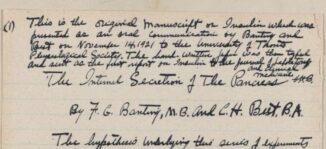
One year earlier, Banting got an idea after reading an article about diabetes and jotted it down. That week Banting met J. J. R. Macleod, who later arranged for Banting to use the Physiology Labs at the University to try out his idea.
It took around 7 months for Banting and Best to make their discovery, which they published as “The internal secretion of the pancreas” in the Journal of Laboratory and Clinical Medicine. Six months later an extract was developed which successfully alleviated the symptoms of diabetes in human beings and Best was put in charge of the production of what would soon be named ‘insulin’ for all of Canada.
By 1923, insulin had become widely available in mass production, with royalties from licensing agreements going to the University, and Banting and Macleod were awarded the Nobel Prize in Medicine. Being a graduate student, Best was not included, but Banting recognized his contribution and shared his award money. (1921)
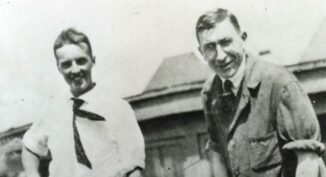 Banting and Best, 1921-Expired Copyright- Library and Archives Canada / C-001350
Banting and Best, 1921-Expired Copyright- Library and Archives Canada / C-001350And 173 years ago today, Herman Melville’s novel Moby Dick was published. With one of the most famous opening lines in literature, “Call me Ishmael,” a sailor tells the story of the obsessive quest of Captain Ahab for revenge on a white whale that bit off the whaler’s leg at the knee.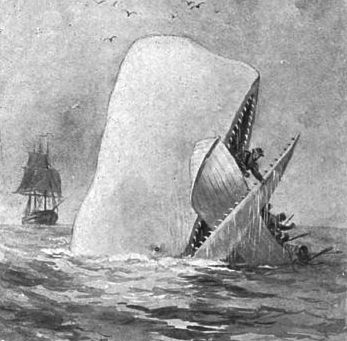
The novel was a commercial failure, and out of print at the time of the author’s death 40 years later, but during the 20th century, it earned a reputation as a Great American Novel. “The book draws on Melville’s experience at sea, on whaling literature, and on literary inspirations such as Shakespeare and the Bible to offer a realistic description of life aboard ship with a culturally diverse crew.” (1851)
And on this day in 1982, Lech Wałęsa, the leader of Poland’s outlawed Solidarity movement, was released after eleven months of persecution and internment near the Soviet border.
 Photo by Giedymin Jabłoński – CC license
Photo by Giedymin Jabłoński – CC licenseTwo years earlier the electrician had won a sweeping victory with communist rulers for the right to organize independent unions that could strike. He continued his activism, which culminated in semi-free parliamentary elections in 1989 and a Solidarity-led government, with a reluctant Walesa becoming Poland’s first popularly elected president the following year—the first non-Communist president in nearly a half century.
Also, 135 years ago today, pioneering female journalist Nellie Bly began her record-breaking attempt to travel around the world in 80 days.
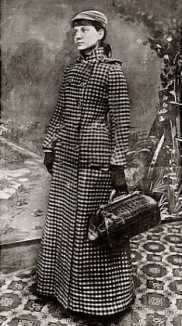 Promotional photo taken by New York World before her trip
Promotional photo taken by New York World before her tripShe succeeded—and needed only 72. She wanted to prove that the Jules Verne fictional journey Around the World in 80 Days could be achieved and traveled 24,899 miles, mostly alone, using steamships and trains, wearing only the dress on her back, a sturdy overcoat and carrying a small travel bag with toiletries and underwear.
While circumnavigating the globe for her newspaper, New York World, she was able to send short progress reports via submarine cable networks and the electric telegraph. Longer dispatches had to travel by regular post and thus, were delayed by several weeks. During her historic trip, she met Jules Verne in France, visited a leper colony in China and, in Singapore, she bought a monkey.
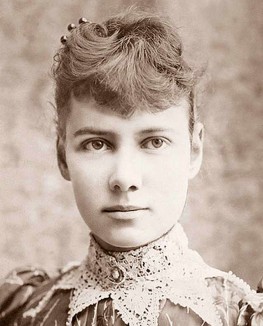
Bly, whose real name was Elizabeth Jane Cochrane, first became renowned for her undercover investigation on insane asylum conditions, during which she pretended to be mad. Her expose led to a grand jury investigation and $850,000 in increased funds to care for the insane.
Bly’s career began when she was 16, after a misogynistic column, “What Girls Are Good For,” ran in the Pittsburgh Dispatch and prompted her to write a fiery anonymous rebuttal to the editor. He was so impressed with her passion that he ran an advertisement asking the author to identify herself. When Ms. Cochrane introduced herself to the editor, George Madden, he offered her the opportunity to write a piece for the newspaper. Nellie wrote books about her experiences, and there are stories for children about her trip. (1889)
184 years ago today, Claude Monet, one of the founding painters of French Impressionism, was born in Paris.
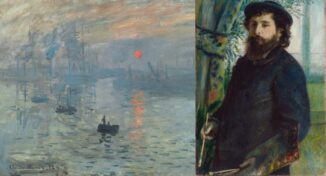
He became the driving force of the movement with his broken dashes of color and rapid brushstrokes. The term ‘Impressionism’ derived from the title of his painting Impression, Sunrise; which was displayed in a pivotal 1874 exhibition—the first to be organized by the artists of this pioneering new school.
Monet painted the same natural landscapes repeatedly at different times of day to reveal the transformations of light and color throughout the day and passing seasons—and became beloved for his later depictions of lily ponds outside his Giverny countryside home which occupied him for 20 years.
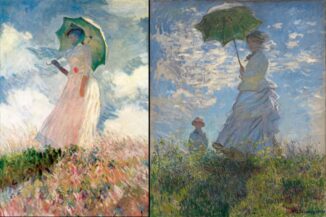
His father had wanted the boy to go into the family’s grocery business, but his mother was a singer, and supported her son’s desire for a career in art. Monet died at age 86 and was buried in the Giverny church cemetery. At his funeral, his long-time friend Georges Clemenceau removed the black cloth draped over the coffin, stating, “No black for Monet!“ and replaced it with flowered fabric. See more paintings on Wikipedia and WATCH a mini-doc… (1840)
SHARE the Milestones, Memories, and Memories…
Source link

